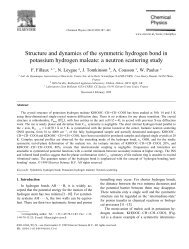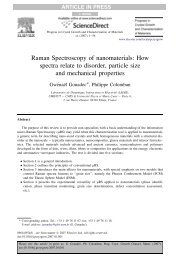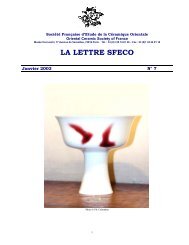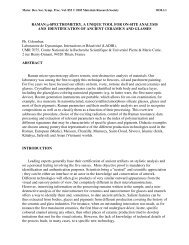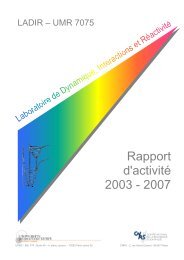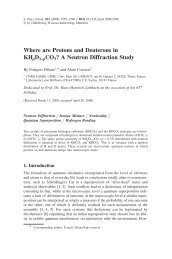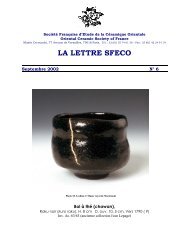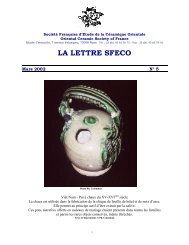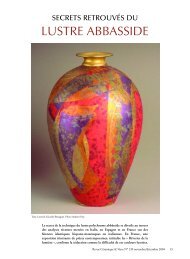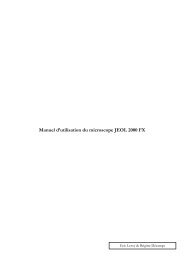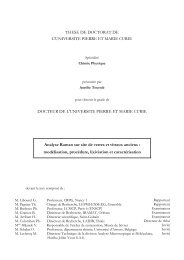12 Nano/microstructure - institut de chimie et des materiaux paris-est
12 Nano/microstructure - institut de chimie et des materiaux paris-est
12 Nano/microstructure - institut de chimie et des materiaux paris-est
- No tags were found...
Create successful ePaper yourself
Turn your PDF publications into a flip-book with our unique Google optimized e-Paper software.
DK4027_book.fm Page 315 Monday, May 16, 2005 2:01 PM<strong>Nano</strong>/<strong>microstructure</strong> and Multiphase Materials 315IV. COMPOSITES AND MULTIPHASE MATERIALSA. PARTICULATE-REINFORCED MATERIALSThe “simpl<strong>est</strong>” application of sol-gel materials is as abrasive grains. Abrasiveparticles can be dispersed into vitrified or resin-bon<strong>de</strong>d grinding wheels, coatedabrasive belts, she<strong>et</strong>s, and discs. In 1981, 3M Company introduced the first solgelabrasive particle, referred to as Cubitron, in the Regal-coated abrasive fiberdisc product line. 55 The i<strong>de</strong>a to use sol-gel processing originated from the processingroute of ceramic fibers <strong>de</strong>veloped at 3M by Sowman 56 some years before.Commercially available boehmite (AlOOH) sol is <strong>de</strong>rived from the hydrolysis ofaluminum alkoxi<strong>de</strong>, a by-product of the Ziegler process for the production oflong-chain alcohols. When a m<strong>et</strong>al salt is ad<strong>de</strong>d to the boehmite sol, it provokesgelation and a stiff gel is formed. Afterwards this gel is dried, crushed, andscreened to the appropriate size distribution, calcined, and then sintered at atemperature b<strong>et</strong>ween <strong>12</strong>00 and 1600°C. The resulting material is screened andready to be used as an abrasive particle.Nonoxi<strong>de</strong> ceramics are finding increasing applications as high-speed cuttingtools for m<strong>et</strong>als. 57 The combination of sol-gel processing and reaction-sintering hasbeen used to prepare <strong>de</strong>nse nonoxi<strong>de</strong> abrasive grit. 58 An Al 2 O 3 sol was prepared bydispersing boehmite pow<strong>de</strong>r into HNO 3 containing water heated to ~80°C. The solwas see<strong>de</strong>d with αAl 2 O 3 crystallites. The abrasive grains were prepared from thedispersion of carbon black and TiO 2 in the see<strong>de</strong>d Al 2 O 3 sol. Glycerol was ad<strong>de</strong>d toprevent oxidation of the carbon black during calcination. The gel was dried, crushed,screened, and calcined at 1000°C and then thermally heated to 1400°C and then to1900°C un<strong>de</strong>r a flowing N 2 atmosphere for the formation of TiN and AlN bycarbothermal reduction. The final <strong>microstructure</strong> (AlN/TiN/AlON) is controlled bythe amount of TiO 2 in the sol and by the carbon content. The great advantage of solgelabrasive particles is the ability to introduce chemical changes, which modify thealumina crystal structure and enable the optimization of grinding.Particulate reinforcement (platel<strong>et</strong>s and whiskers) is used to improve th<strong>et</strong>oughness of small shaped pieces or to facilitate machining. This type of reinforcementis also used to increase the toughness of monolithic ceramics and ofthe matrix of fiber-reinforced composites. Figure <strong>12</strong>.7a shows an example application,a dispersion of submicronic zironia in a mullite matrix in b<strong>et</strong>ween wovenSiC fibers. Another example application is the “machinable” sol-gel preparedmica-ceramic composite that can be cut by a conventional m<strong>et</strong>allic saw 59 and isused as an insulating material for precision machines and as a substrate forelectronic parts. The homogeneous dispersion of anisotropic particles in a pow<strong>de</strong>rand the compaction of the resulting mixture are always difficult because theapplied load <strong>de</strong>creases with the number of contact points. The use of liquid aids(colloidal processing) counteracts this drawback, although imperfectly. Gelembedding offers a new route for the mixing of pow<strong>de</strong>rs and particulate reinforcementsdue to the incorporation of a viscous substance, the reactivity of whichcan be tailored by compositional <strong>de</strong>sign. 37 Cold molding makes it possible toprepare shaped and crack-free pieces. The process is the following: pow<strong>de</strong>r and



